Macro Environmental Forces, Marketing Strategies, Consumer Behavior and Growth Opportunities of Bank of Saint Lucia
VerifiedAdded on 2023/05/31
|13
|3908
|316
AI Summary
This article discusses the macro environmental forces that affect Bank of Saint Lucia, its marketing strategies, impact of consumer behavior, and growth opportunities. It also delves into the segmentation, targeting, and positioning strategies of the bank.
Contribute Materials
Your contribution can guide someone’s learning journey. Share your
documents today.
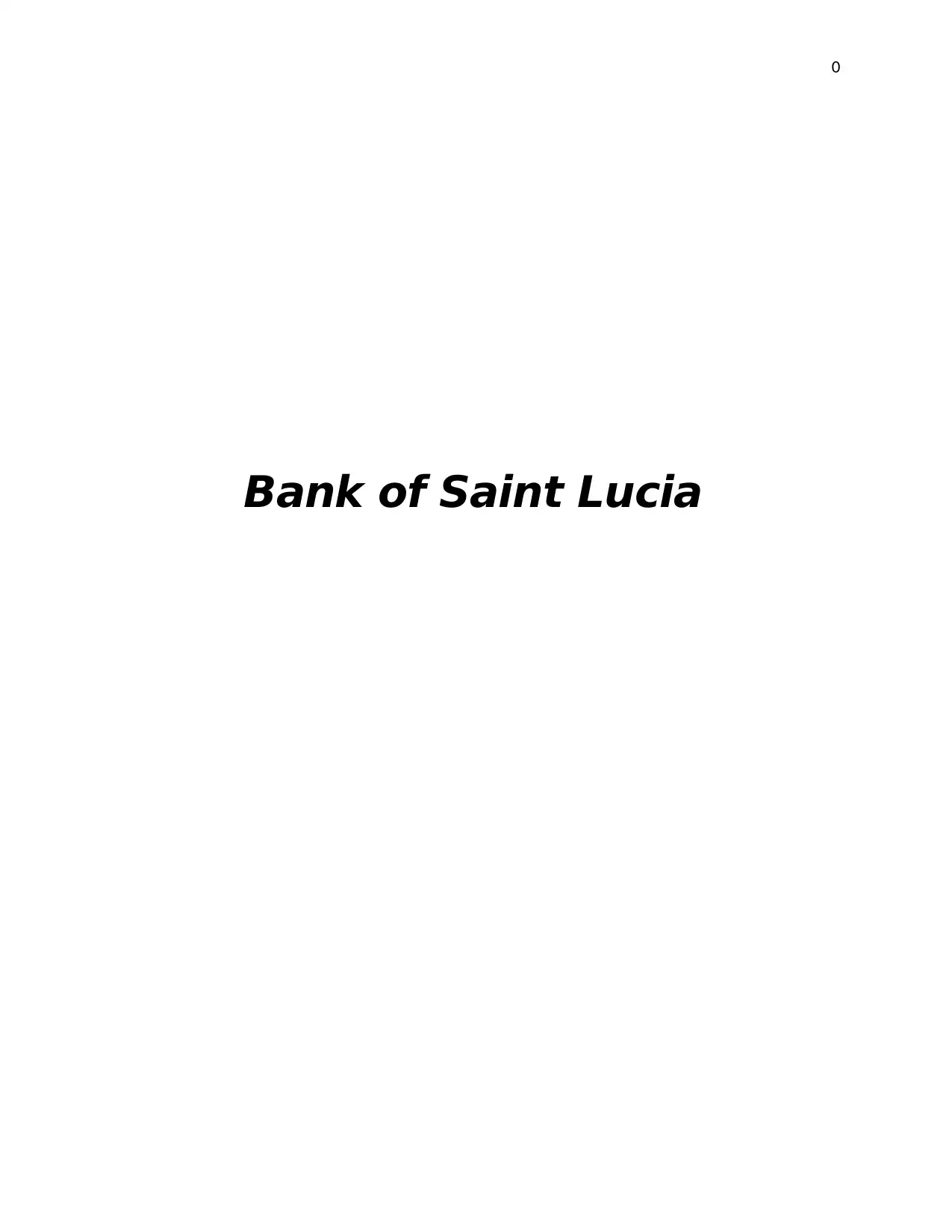
0
Bank of Saint Lucia
Bank of Saint Lucia
Secure Best Marks with AI Grader
Need help grading? Try our AI Grader for instant feedback on your assignments.
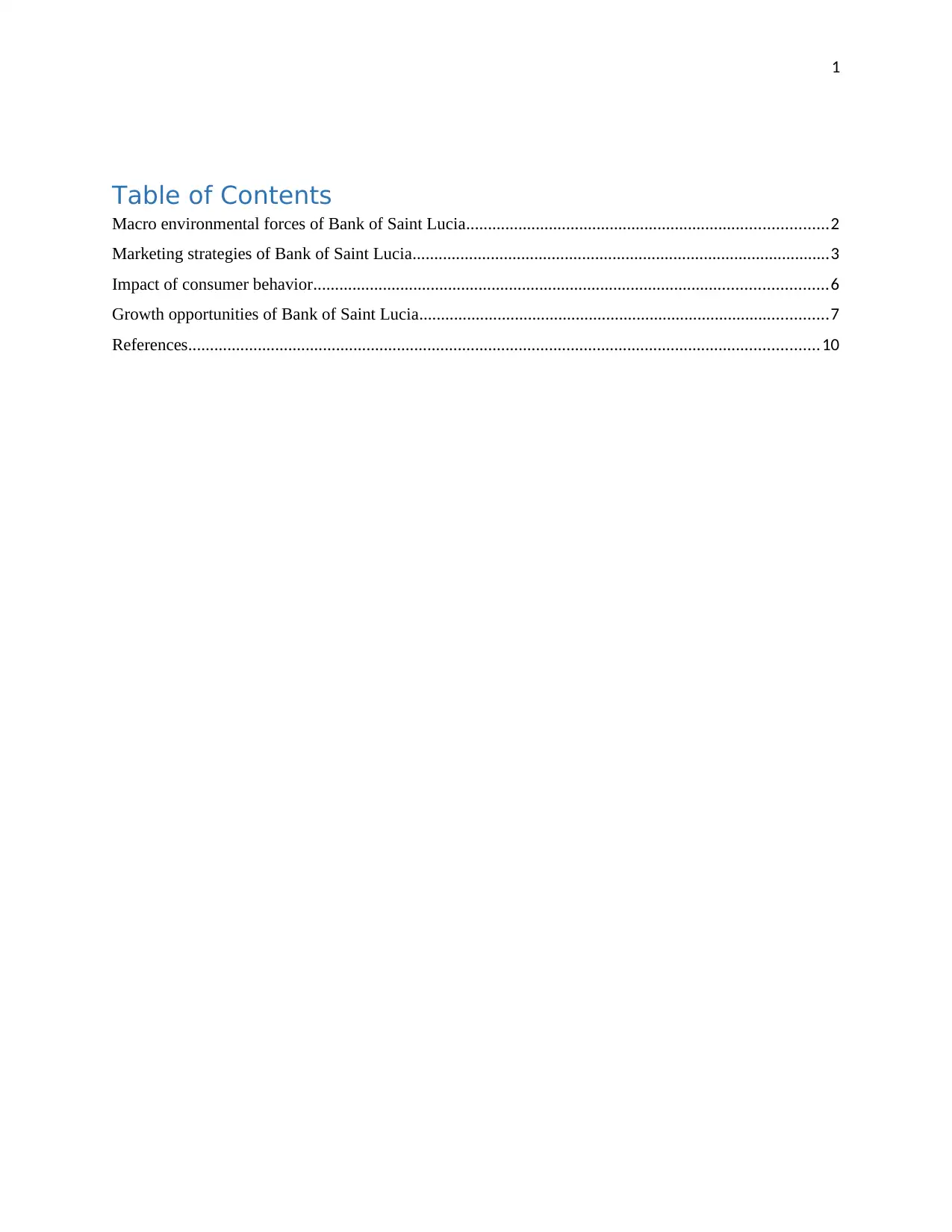
1
Table of Contents
Macro environmental forces of Bank of Saint Lucia...................................................................................2
Marketing strategies of Bank of Saint Lucia................................................................................................3
Impact of consumer behavior......................................................................................................................6
Growth opportunities of Bank of Saint Lucia..............................................................................................7
References.................................................................................................................................................10
Table of Contents
Macro environmental forces of Bank of Saint Lucia...................................................................................2
Marketing strategies of Bank of Saint Lucia................................................................................................3
Impact of consumer behavior......................................................................................................................6
Growth opportunities of Bank of Saint Lucia..............................................................................................7
References.................................................................................................................................................10
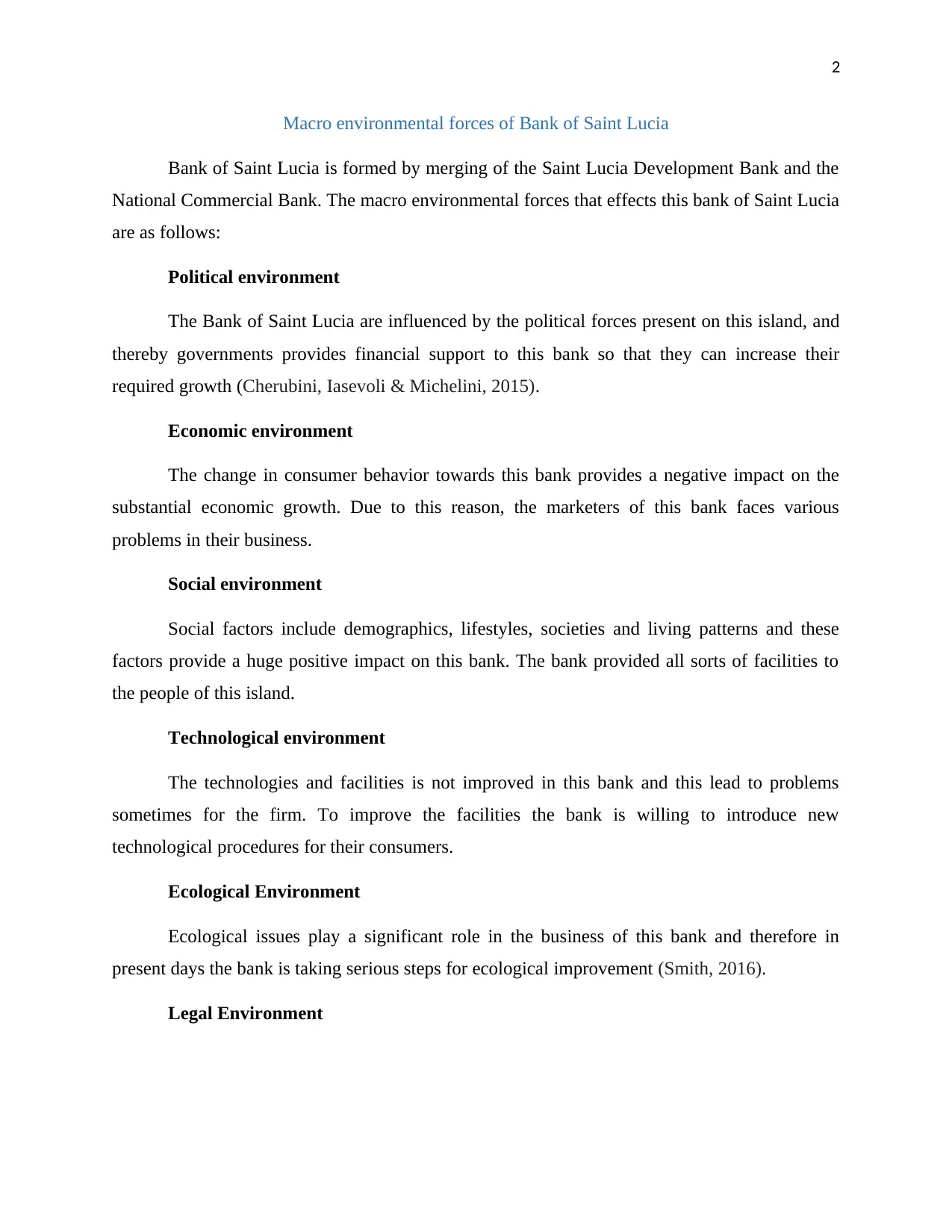
2
Macro environmental forces of Bank of Saint Lucia
Bank of Saint Lucia is formed by merging of the Saint Lucia Development Bank and the
National Commercial Bank. The macro environmental forces that effects this bank of Saint Lucia
are as follows:
Political environment
The Bank of Saint Lucia are influenced by the political forces present on this island, and
thereby governments provides financial support to this bank so that they can increase their
required growth (Cherubini, Iasevoli & Michelini, 2015).
Economic environment
The change in consumer behavior towards this bank provides a negative impact on the
substantial economic growth. Due to this reason, the marketers of this bank faces various
problems in their business.
Social environment
Social factors include demographics, lifestyles, societies and living patterns and these
factors provide a huge positive impact on this bank. The bank provided all sorts of facilities to
the people of this island.
Technological environment
The technologies and facilities is not improved in this bank and this lead to problems
sometimes for the firm. To improve the facilities the bank is willing to introduce new
technological procedures for their consumers.
Ecological Environment
Ecological issues play a significant role in the business of this bank and therefore in
present days the bank is taking serious steps for ecological improvement (Smith, 2016).
Legal Environment
Macro environmental forces of Bank of Saint Lucia
Bank of Saint Lucia is formed by merging of the Saint Lucia Development Bank and the
National Commercial Bank. The macro environmental forces that effects this bank of Saint Lucia
are as follows:
Political environment
The Bank of Saint Lucia are influenced by the political forces present on this island, and
thereby governments provides financial support to this bank so that they can increase their
required growth (Cherubini, Iasevoli & Michelini, 2015).
Economic environment
The change in consumer behavior towards this bank provides a negative impact on the
substantial economic growth. Due to this reason, the marketers of this bank faces various
problems in their business.
Social environment
Social factors include demographics, lifestyles, societies and living patterns and these
factors provide a huge positive impact on this bank. The bank provided all sorts of facilities to
the people of this island.
Technological environment
The technologies and facilities is not improved in this bank and this lead to problems
sometimes for the firm. To improve the facilities the bank is willing to introduce new
technological procedures for their consumers.
Ecological Environment
Ecological issues play a significant role in the business of this bank and therefore in
present days the bank is taking serious steps for ecological improvement (Smith, 2016).
Legal Environment
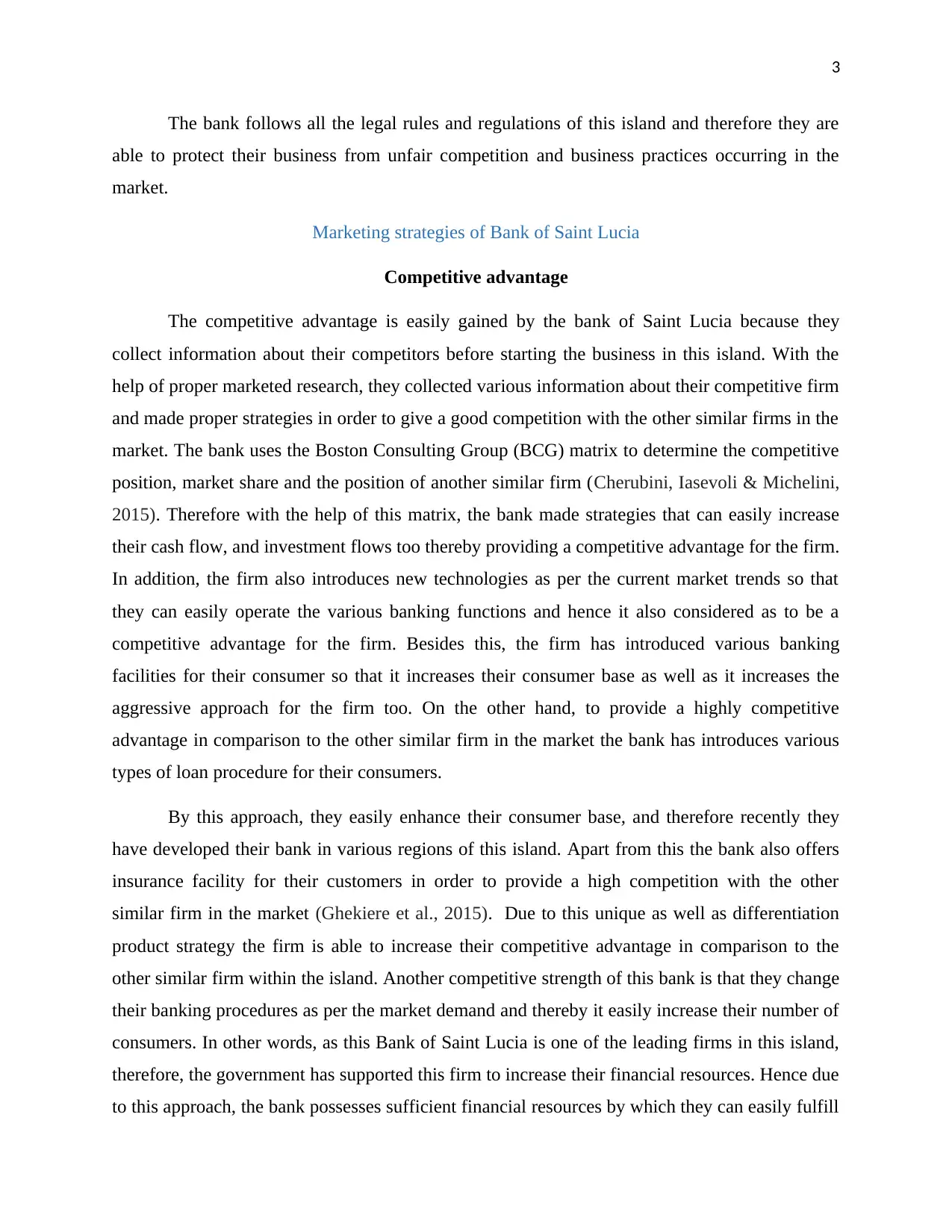
3
The bank follows all the legal rules and regulations of this island and therefore they are
able to protect their business from unfair competition and business practices occurring in the
market.
Marketing strategies of Bank of Saint Lucia
Competitive advantage
The competitive advantage is easily gained by the bank of Saint Lucia because they
collect information about their competitors before starting the business in this island. With the
help of proper marketed research, they collected various information about their competitive firm
and made proper strategies in order to give a good competition with the other similar firms in the
market. The bank uses the Boston Consulting Group (BCG) matrix to determine the competitive
position, market share and the position of another similar firm (Cherubini, Iasevoli & Michelini,
2015). Therefore with the help of this matrix, the bank made strategies that can easily increase
their cash flow, and investment flows too thereby providing a competitive advantage for the firm.
In addition, the firm also introduces new technologies as per the current market trends so that
they can easily operate the various banking functions and hence it also considered as to be a
competitive advantage for the firm. Besides this, the firm has introduced various banking
facilities for their consumer so that it increases their consumer base as well as it increases the
aggressive approach for the firm too. On the other hand, to provide a highly competitive
advantage in comparison to the other similar firm in the market the bank has introduces various
types of loan procedure for their consumers.
By this approach, they easily enhance their consumer base, and therefore recently they
have developed their bank in various regions of this island. Apart from this the bank also offers
insurance facility for their customers in order to provide a high competition with the other
similar firm in the market (Ghekiere et al., 2015). Due to this unique as well as differentiation
product strategy the firm is able to increase their competitive advantage in comparison to the
other similar firm within the island. Another competitive strength of this bank is that they change
their banking procedures as per the market demand and thereby it easily increase their number of
consumers. In other words, as this Bank of Saint Lucia is one of the leading firms in this island,
therefore, the government has supported this firm to increase their financial resources. Hence due
to this approach, the bank possesses sufficient financial resources by which they can easily fulfill
The bank follows all the legal rules and regulations of this island and therefore they are
able to protect their business from unfair competition and business practices occurring in the
market.
Marketing strategies of Bank of Saint Lucia
Competitive advantage
The competitive advantage is easily gained by the bank of Saint Lucia because they
collect information about their competitors before starting the business in this island. With the
help of proper marketed research, they collected various information about their competitive firm
and made proper strategies in order to give a good competition with the other similar firms in the
market. The bank uses the Boston Consulting Group (BCG) matrix to determine the competitive
position, market share and the position of another similar firm (Cherubini, Iasevoli & Michelini,
2015). Therefore with the help of this matrix, the bank made strategies that can easily increase
their cash flow, and investment flows too thereby providing a competitive advantage for the firm.
In addition, the firm also introduces new technologies as per the current market trends so that
they can easily operate the various banking functions and hence it also considered as to be a
competitive advantage for the firm. Besides this, the firm has introduced various banking
facilities for their consumer so that it increases their consumer base as well as it increases the
aggressive approach for the firm too. On the other hand, to provide a highly competitive
advantage in comparison to the other similar firm in the market the bank has introduces various
types of loan procedure for their consumers.
By this approach, they easily enhance their consumer base, and therefore recently they
have developed their bank in various regions of this island. Apart from this the bank also offers
insurance facility for their customers in order to provide a high competition with the other
similar firm in the market (Ghekiere et al., 2015). Due to this unique as well as differentiation
product strategy the firm is able to increase their competitive advantage in comparison to the
other similar firm within the island. Another competitive strength of this bank is that they change
their banking procedures as per the market demand and thereby it easily increase their number of
consumers. In other words, as this Bank of Saint Lucia is one of the leading firms in this island,
therefore, the government has supported this firm to increase their financial resources. Hence due
to this approach, the bank possesses sufficient financial resources by which they can easily fulfill
Secure Best Marks with AI Grader
Need help grading? Try our AI Grader for instant feedback on your assignments.
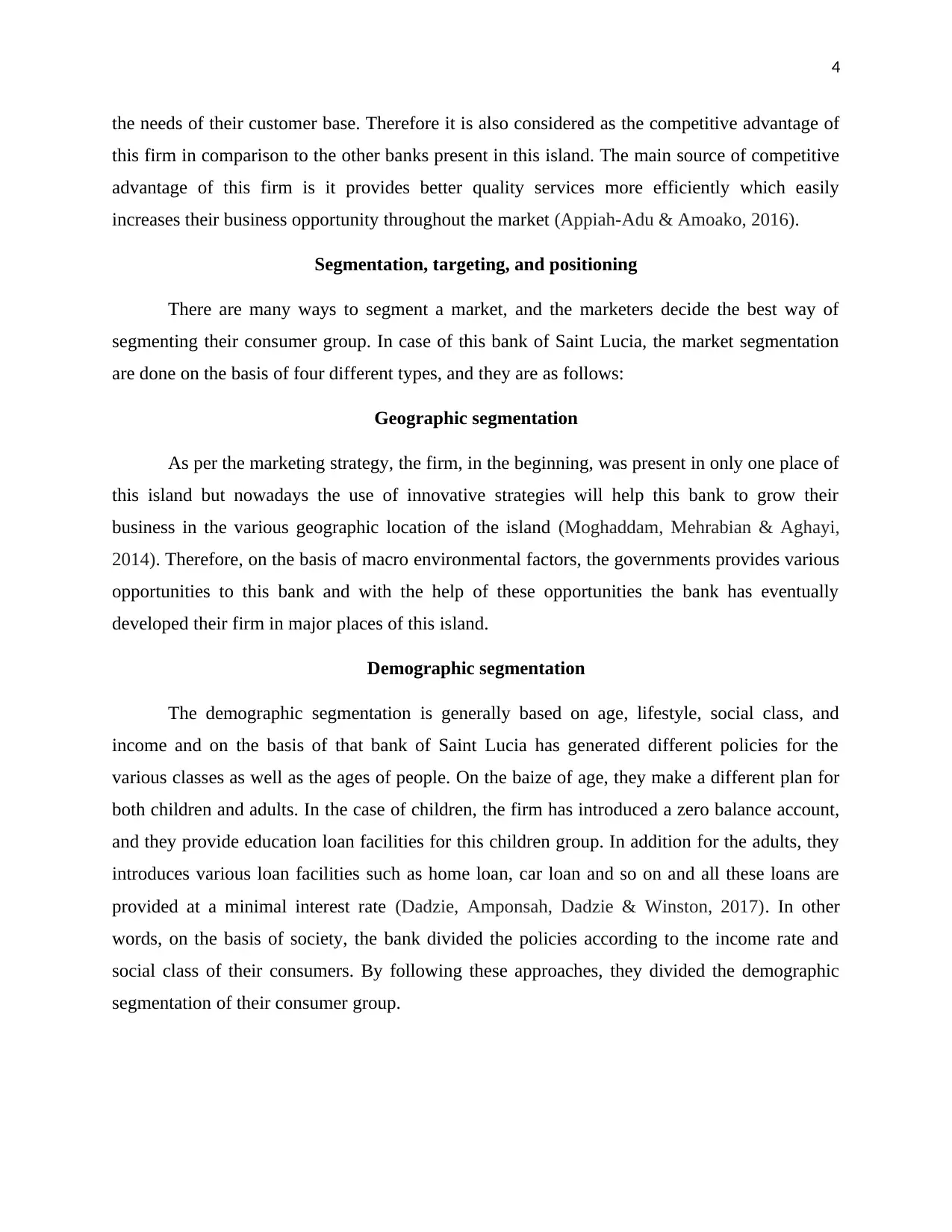
4
the needs of their customer base. Therefore it is also considered as the competitive advantage of
this firm in comparison to the other banks present in this island. The main source of competitive
advantage of this firm is it provides better quality services more efficiently which easily
increases their business opportunity throughout the market (Appiah-Adu & Amoako, 2016).
Segmentation, targeting, and positioning
There are many ways to segment a market, and the marketers decide the best way of
segmenting their consumer group. In case of this bank of Saint Lucia, the market segmentation
are done on the basis of four different types, and they are as follows:
Geographic segmentation
As per the marketing strategy, the firm, in the beginning, was present in only one place of
this island but nowadays the use of innovative strategies will help this bank to grow their
business in the various geographic location of the island (Moghaddam, Mehrabian & Aghayi,
2014). Therefore, on the basis of macro environmental factors, the governments provides various
opportunities to this bank and with the help of these opportunities the bank has eventually
developed their firm in major places of this island.
Demographic segmentation
The demographic segmentation is generally based on age, lifestyle, social class, and
income and on the basis of that bank of Saint Lucia has generated different policies for the
various classes as well as the ages of people. On the baize of age, they make a different plan for
both children and adults. In the case of children, the firm has introduced a zero balance account,
and they provide education loan facilities for this children group. In addition for the adults, they
introduces various loan facilities such as home loan, car loan and so on and all these loans are
provided at a minimal interest rate (Dadzie, Amponsah, Dadzie & Winston, 2017). In other
words, on the basis of society, the bank divided the policies according to the income rate and
social class of their consumers. By following these approaches, they divided the demographic
segmentation of their consumer group.
the needs of their customer base. Therefore it is also considered as the competitive advantage of
this firm in comparison to the other banks present in this island. The main source of competitive
advantage of this firm is it provides better quality services more efficiently which easily
increases their business opportunity throughout the market (Appiah-Adu & Amoako, 2016).
Segmentation, targeting, and positioning
There are many ways to segment a market, and the marketers decide the best way of
segmenting their consumer group. In case of this bank of Saint Lucia, the market segmentation
are done on the basis of four different types, and they are as follows:
Geographic segmentation
As per the marketing strategy, the firm, in the beginning, was present in only one place of
this island but nowadays the use of innovative strategies will help this bank to grow their
business in the various geographic location of the island (Moghaddam, Mehrabian & Aghayi,
2014). Therefore, on the basis of macro environmental factors, the governments provides various
opportunities to this bank and with the help of these opportunities the bank has eventually
developed their firm in major places of this island.
Demographic segmentation
The demographic segmentation is generally based on age, lifestyle, social class, and
income and on the basis of that bank of Saint Lucia has generated different policies for the
various classes as well as the ages of people. On the baize of age, they make a different plan for
both children and adults. In the case of children, the firm has introduced a zero balance account,
and they provide education loan facilities for this children group. In addition for the adults, they
introduces various loan facilities such as home loan, car loan and so on and all these loans are
provided at a minimal interest rate (Dadzie, Amponsah, Dadzie & Winston, 2017). In other
words, on the basis of society, the bank divided the policies according to the income rate and
social class of their consumers. By following these approaches, they divided the demographic
segmentation of their consumer group.
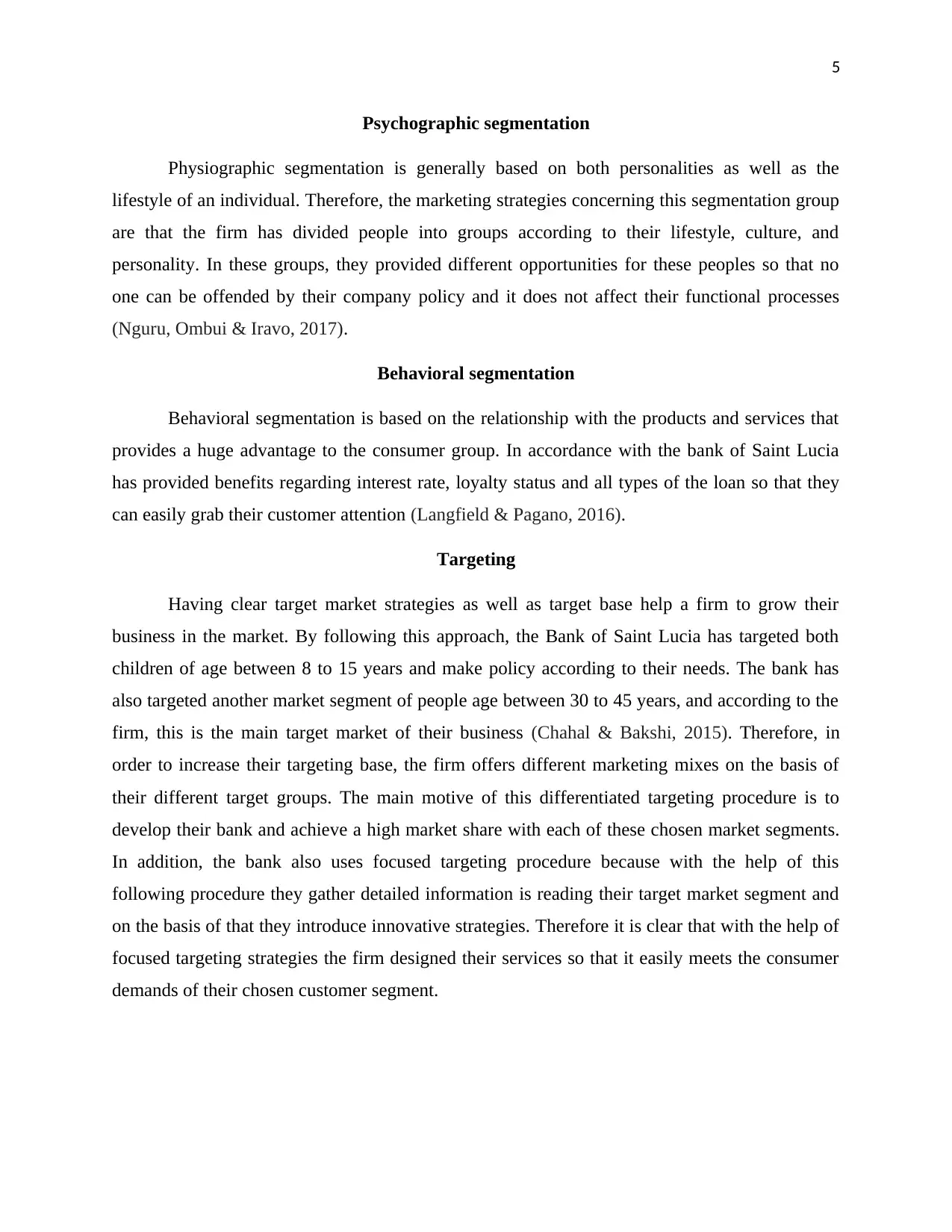
5
Psychographic segmentation
Physiographic segmentation is generally based on both personalities as well as the
lifestyle of an individual. Therefore, the marketing strategies concerning this segmentation group
are that the firm has divided people into groups according to their lifestyle, culture, and
personality. In these groups, they provided different opportunities for these peoples so that no
one can be offended by their company policy and it does not affect their functional processes
(Nguru, Ombui & Iravo, 2017).
Behavioral segmentation
Behavioral segmentation is based on the relationship with the products and services that
provides a huge advantage to the consumer group. In accordance with the bank of Saint Lucia
has provided benefits regarding interest rate, loyalty status and all types of the loan so that they
can easily grab their customer attention (Langfield & Pagano, 2016).
Targeting
Having clear target market strategies as well as target base help a firm to grow their
business in the market. By following this approach, the Bank of Saint Lucia has targeted both
children of age between 8 to 15 years and make policy according to their needs. The bank has
also targeted another market segment of people age between 30 to 45 years, and according to the
firm, this is the main target market of their business (Chahal & Bakshi, 2015). Therefore, in
order to increase their targeting base, the firm offers different marketing mixes on the basis of
their different target groups. The main motive of this differentiated targeting procedure is to
develop their bank and achieve a high market share with each of these chosen market segments.
In addition, the bank also uses focused targeting procedure because with the help of this
following procedure they gather detailed information is reading their target market segment and
on the basis of that they introduce innovative strategies. Therefore it is clear that with the help of
focused targeting strategies the firm designed their services so that it easily meets the consumer
demands of their chosen customer segment.
Psychographic segmentation
Physiographic segmentation is generally based on both personalities as well as the
lifestyle of an individual. Therefore, the marketing strategies concerning this segmentation group
are that the firm has divided people into groups according to their lifestyle, culture, and
personality. In these groups, they provided different opportunities for these peoples so that no
one can be offended by their company policy and it does not affect their functional processes
(Nguru, Ombui & Iravo, 2017).
Behavioral segmentation
Behavioral segmentation is based on the relationship with the products and services that
provides a huge advantage to the consumer group. In accordance with the bank of Saint Lucia
has provided benefits regarding interest rate, loyalty status and all types of the loan so that they
can easily grab their customer attention (Langfield & Pagano, 2016).
Targeting
Having clear target market strategies as well as target base help a firm to grow their
business in the market. By following this approach, the Bank of Saint Lucia has targeted both
children of age between 8 to 15 years and make policy according to their needs. The bank has
also targeted another market segment of people age between 30 to 45 years, and according to the
firm, this is the main target market of their business (Chahal & Bakshi, 2015). Therefore, in
order to increase their targeting base, the firm offers different marketing mixes on the basis of
their different target groups. The main motive of this differentiated targeting procedure is to
develop their bank and achieve a high market share with each of these chosen market segments.
In addition, the bank also uses focused targeting procedure because with the help of this
following procedure they gather detailed information is reading their target market segment and
on the basis of that they introduce innovative strategies. Therefore it is clear that with the help of
focused targeting strategies the firm designed their services so that it easily meets the consumer
demands of their chosen customer segment.
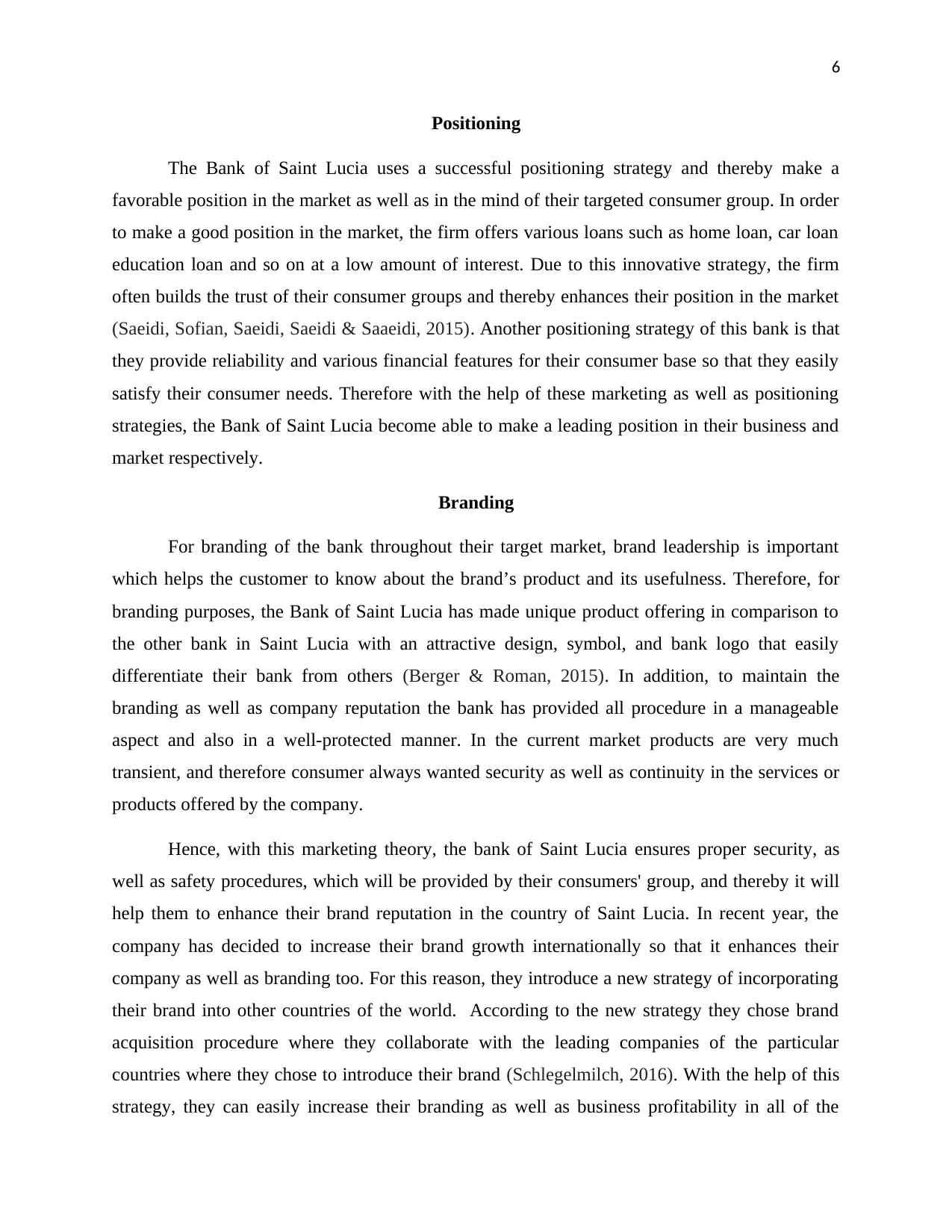
6
Positioning
The Bank of Saint Lucia uses a successful positioning strategy and thereby make a
favorable position in the market as well as in the mind of their targeted consumer group. In order
to make a good position in the market, the firm offers various loans such as home loan, car loan
education loan and so on at a low amount of interest. Due to this innovative strategy, the firm
often builds the trust of their consumer groups and thereby enhances their position in the market
(Saeidi, Sofian, Saeidi, Saeidi & Saaeidi, 2015). Another positioning strategy of this bank is that
they provide reliability and various financial features for their consumer base so that they easily
satisfy their consumer needs. Therefore with the help of these marketing as well as positioning
strategies, the Bank of Saint Lucia become able to make a leading position in their business and
market respectively.
Branding
For branding of the bank throughout their target market, brand leadership is important
which helps the customer to know about the brand’s product and its usefulness. Therefore, for
branding purposes, the Bank of Saint Lucia has made unique product offering in comparison to
the other bank in Saint Lucia with an attractive design, symbol, and bank logo that easily
differentiate their bank from others (Berger & Roman, 2015). In addition, to maintain the
branding as well as company reputation the bank has provided all procedure in a manageable
aspect and also in a well-protected manner. In the current market products are very much
transient, and therefore consumer always wanted security as well as continuity in the services or
products offered by the company.
Hence, with this marketing theory, the bank of Saint Lucia ensures proper security, as
well as safety procedures, which will be provided by their consumers' group, and thereby it will
help them to enhance their brand reputation in the country of Saint Lucia. In recent year, the
company has decided to increase their brand growth internationally so that it enhances their
company as well as branding too. For this reason, they introduce a new strategy of incorporating
their brand into other countries of the world. According to the new strategy they chose brand
acquisition procedure where they collaborate with the leading companies of the particular
countries where they chose to introduce their brand (Schlegelmilch, 2016). With the help of this
strategy, they can easily increase their branding as well as business profitability in all of the
Positioning
The Bank of Saint Lucia uses a successful positioning strategy and thereby make a
favorable position in the market as well as in the mind of their targeted consumer group. In order
to make a good position in the market, the firm offers various loans such as home loan, car loan
education loan and so on at a low amount of interest. Due to this innovative strategy, the firm
often builds the trust of their consumer groups and thereby enhances their position in the market
(Saeidi, Sofian, Saeidi, Saeidi & Saaeidi, 2015). Another positioning strategy of this bank is that
they provide reliability and various financial features for their consumer base so that they easily
satisfy their consumer needs. Therefore with the help of these marketing as well as positioning
strategies, the Bank of Saint Lucia become able to make a leading position in their business and
market respectively.
Branding
For branding of the bank throughout their target market, brand leadership is important
which helps the customer to know about the brand’s product and its usefulness. Therefore, for
branding purposes, the Bank of Saint Lucia has made unique product offering in comparison to
the other bank in Saint Lucia with an attractive design, symbol, and bank logo that easily
differentiate their bank from others (Berger & Roman, 2015). In addition, to maintain the
branding as well as company reputation the bank has provided all procedure in a manageable
aspect and also in a well-protected manner. In the current market products are very much
transient, and therefore consumer always wanted security as well as continuity in the services or
products offered by the company.
Hence, with this marketing theory, the bank of Saint Lucia ensures proper security, as
well as safety procedures, which will be provided by their consumers' group, and thereby it will
help them to enhance their brand reputation in the country of Saint Lucia. In recent year, the
company has decided to increase their brand growth internationally so that it enhances their
company as well as branding too. For this reason, they introduce a new strategy of incorporating
their brand into other countries of the world. According to the new strategy they chose brand
acquisition procedure where they collaborate with the leading companies of the particular
countries where they chose to introduce their brand (Schlegelmilch, 2016). With the help of this
strategy, they can easily increase their branding as well as business profitability in all of the
Paraphrase This Document
Need a fresh take? Get an instant paraphrase of this document with our AI Paraphraser
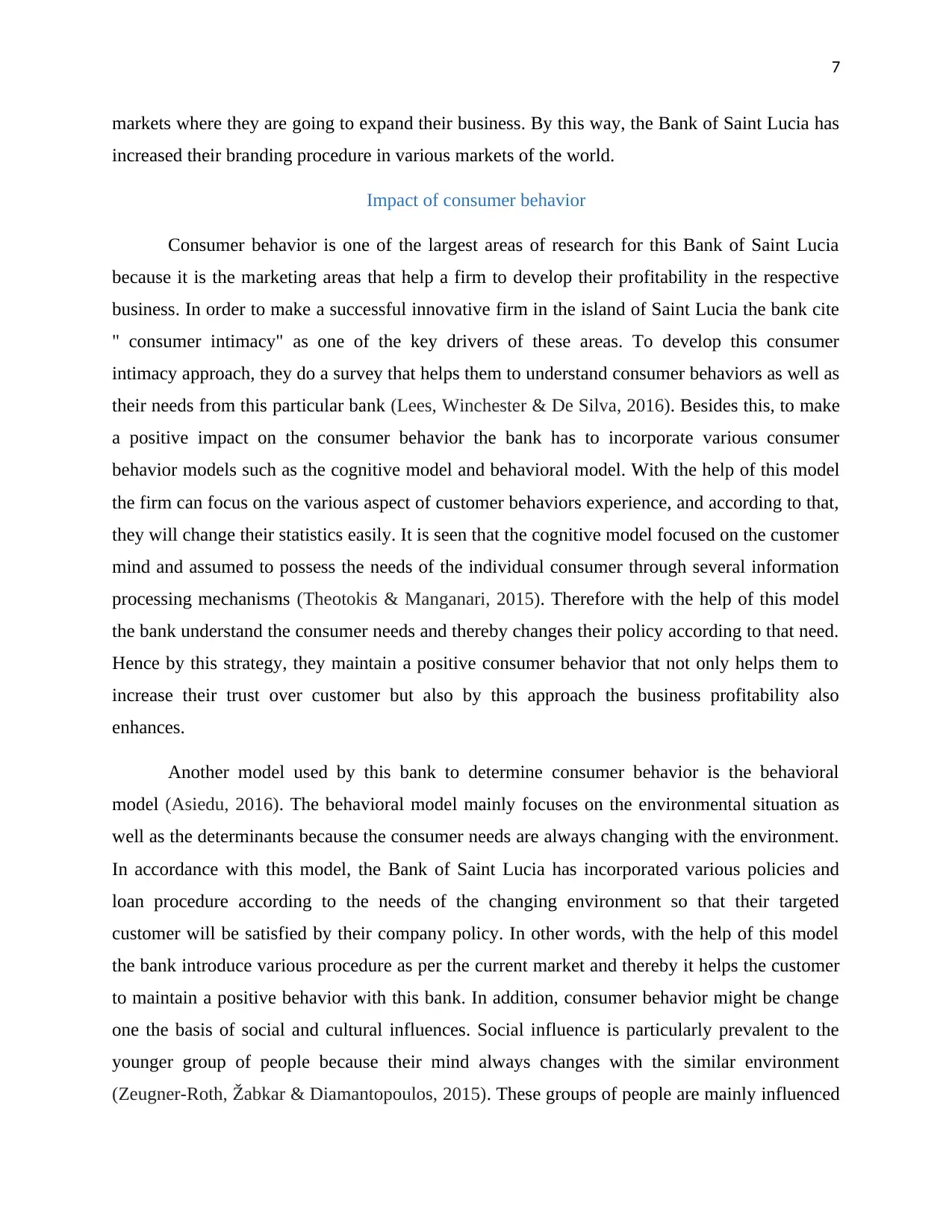
7
markets where they are going to expand their business. By this way, the Bank of Saint Lucia has
increased their branding procedure in various markets of the world.
Impact of consumer behavior
Consumer behavior is one of the largest areas of research for this Bank of Saint Lucia
because it is the marketing areas that help a firm to develop their profitability in the respective
business. In order to make a successful innovative firm in the island of Saint Lucia the bank cite
" consumer intimacy" as one of the key drivers of these areas. To develop this consumer
intimacy approach, they do a survey that helps them to understand consumer behaviors as well as
their needs from this particular bank (Lees, Winchester & De Silva, 2016). Besides this, to make
a positive impact on the consumer behavior the bank has to incorporate various consumer
behavior models such as the cognitive model and behavioral model. With the help of this model
the firm can focus on the various aspect of customer behaviors experience, and according to that,
they will change their statistics easily. It is seen that the cognitive model focused on the customer
mind and assumed to possess the needs of the individual consumer through several information
processing mechanisms (Theotokis & Manganari, 2015). Therefore with the help of this model
the bank understand the consumer needs and thereby changes their policy according to that need.
Hence by this strategy, they maintain a positive consumer behavior that not only helps them to
increase their trust over customer but also by this approach the business profitability also
enhances.
Another model used by this bank to determine consumer behavior is the behavioral
model (Asiedu, 2016). The behavioral model mainly focuses on the environmental situation as
well as the determinants because the consumer needs are always changing with the environment.
In accordance with this model, the Bank of Saint Lucia has incorporated various policies and
loan procedure according to the needs of the changing environment so that their targeted
customer will be satisfied by their company policy. In other words, with the help of this model
the bank introduce various procedure as per the current market and thereby it helps the customer
to maintain a positive behavior with this bank. In addition, consumer behavior might be change
one the basis of social and cultural influences. Social influence is particularly prevalent to the
younger group of people because their mind always changes with the similar environment
(Zeugner-Roth, Žabkar & Diamantopoulos, 2015). These groups of people are mainly influenced
markets where they are going to expand their business. By this way, the Bank of Saint Lucia has
increased their branding procedure in various markets of the world.
Impact of consumer behavior
Consumer behavior is one of the largest areas of research for this Bank of Saint Lucia
because it is the marketing areas that help a firm to develop their profitability in the respective
business. In order to make a successful innovative firm in the island of Saint Lucia the bank cite
" consumer intimacy" as one of the key drivers of these areas. To develop this consumer
intimacy approach, they do a survey that helps them to understand consumer behaviors as well as
their needs from this particular bank (Lees, Winchester & De Silva, 2016). Besides this, to make
a positive impact on the consumer behavior the bank has to incorporate various consumer
behavior models such as the cognitive model and behavioral model. With the help of this model
the firm can focus on the various aspect of customer behaviors experience, and according to that,
they will change their statistics easily. It is seen that the cognitive model focused on the customer
mind and assumed to possess the needs of the individual consumer through several information
processing mechanisms (Theotokis & Manganari, 2015). Therefore with the help of this model
the bank understand the consumer needs and thereby changes their policy according to that need.
Hence by this strategy, they maintain a positive consumer behavior that not only helps them to
increase their trust over customer but also by this approach the business profitability also
enhances.
Another model used by this bank to determine consumer behavior is the behavioral
model (Asiedu, 2016). The behavioral model mainly focuses on the environmental situation as
well as the determinants because the consumer needs are always changing with the environment.
In accordance with this model, the Bank of Saint Lucia has incorporated various policies and
loan procedure according to the needs of the changing environment so that their targeted
customer will be satisfied by their company policy. In other words, with the help of this model
the bank introduce various procedure as per the current market and thereby it helps the customer
to maintain a positive behavior with this bank. In addition, consumer behavior might be change
one the basis of social and cultural influences. Social influence is particularly prevalent to the
younger group of people because their mind always changes with the similar environment
(Zeugner-Roth, Žabkar & Diamantopoulos, 2015). These groups of people are mainly influenced
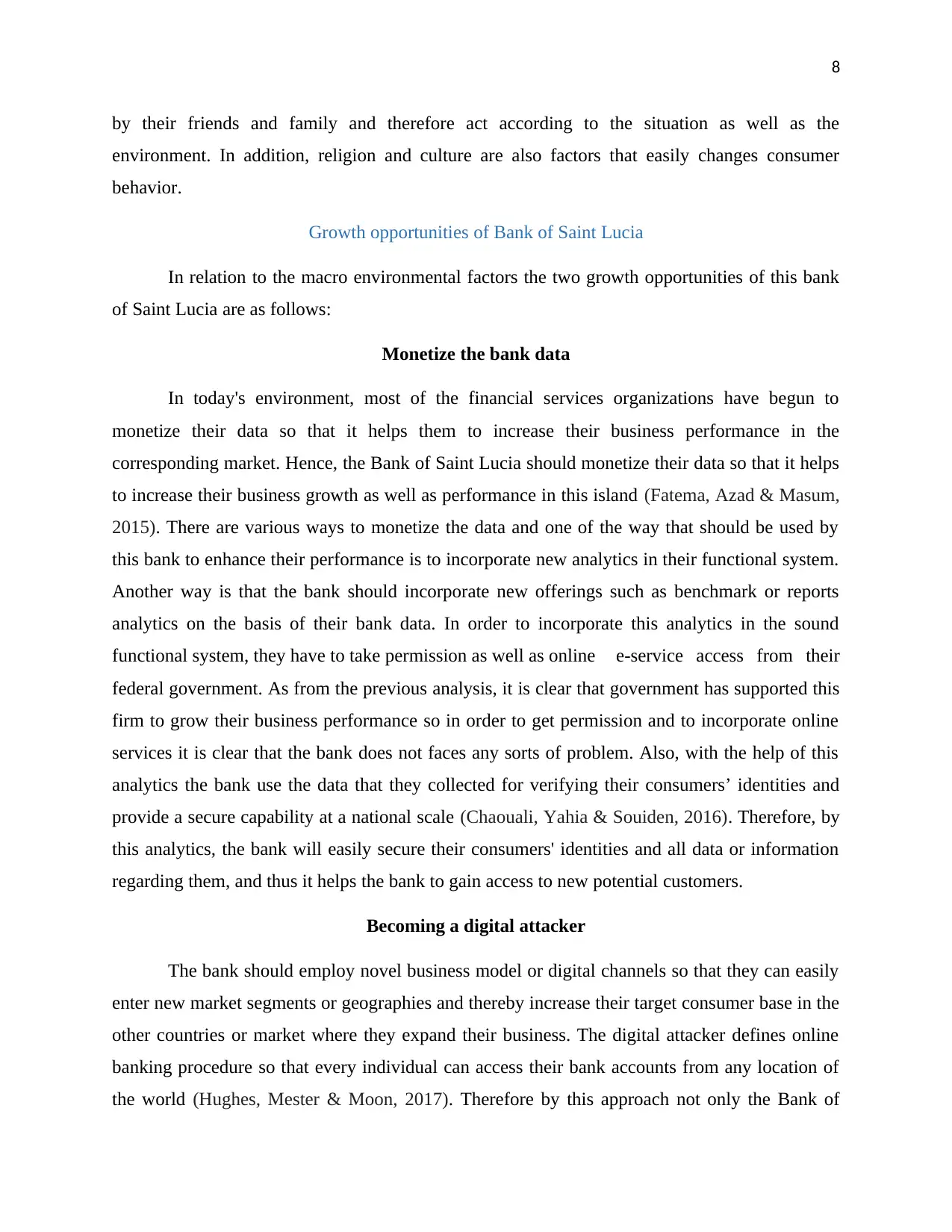
8
by their friends and family and therefore act according to the situation as well as the
environment. In addition, religion and culture are also factors that easily changes consumer
behavior.
Growth opportunities of Bank of Saint Lucia
In relation to the macro environmental factors the two growth opportunities of this bank
of Saint Lucia are as follows:
Monetize the bank data
In today's environment, most of the financial services organizations have begun to
monetize their data so that it helps them to increase their business performance in the
corresponding market. Hence, the Bank of Saint Lucia should monetize their data so that it helps
to increase their business growth as well as performance in this island (Fatema, Azad & Masum,
2015). There are various ways to monetize the data and one of the way that should be used by
this bank to enhance their performance is to incorporate new analytics in their functional system.
Another way is that the bank should incorporate new offerings such as benchmark or reports
analytics on the basis of their bank data. In order to incorporate this analytics in the sound
functional system, they have to take permission as well as online e-service access from their
federal government. As from the previous analysis, it is clear that government has supported this
firm to grow their business performance so in order to get permission and to incorporate online
services it is clear that the bank does not faces any sorts of problem. Also, with the help of this
analytics the bank use the data that they collected for verifying their consumers’ identities and
provide a secure capability at a national scale (Chaouali, Yahia & Souiden, 2016). Therefore, by
this analytics, the bank will easily secure their consumers' identities and all data or information
regarding them, and thus it helps the bank to gain access to new potential customers.
Becoming a digital attacker
The bank should employ novel business model or digital channels so that they can easily
enter new market segments or geographies and thereby increase their target consumer base in the
other countries or market where they expand their business. The digital attacker defines online
banking procedure so that every individual can access their bank accounts from any location of
the world (Hughes, Mester & Moon, 2017). Therefore by this approach not only the Bank of
by their friends and family and therefore act according to the situation as well as the
environment. In addition, religion and culture are also factors that easily changes consumer
behavior.
Growth opportunities of Bank of Saint Lucia
In relation to the macro environmental factors the two growth opportunities of this bank
of Saint Lucia are as follows:
Monetize the bank data
In today's environment, most of the financial services organizations have begun to
monetize their data so that it helps them to increase their business performance in the
corresponding market. Hence, the Bank of Saint Lucia should monetize their data so that it helps
to increase their business growth as well as performance in this island (Fatema, Azad & Masum,
2015). There are various ways to monetize the data and one of the way that should be used by
this bank to enhance their performance is to incorporate new analytics in their functional system.
Another way is that the bank should incorporate new offerings such as benchmark or reports
analytics on the basis of their bank data. In order to incorporate this analytics in the sound
functional system, they have to take permission as well as online e-service access from their
federal government. As from the previous analysis, it is clear that government has supported this
firm to grow their business performance so in order to get permission and to incorporate online
services it is clear that the bank does not faces any sorts of problem. Also, with the help of this
analytics the bank use the data that they collected for verifying their consumers’ identities and
provide a secure capability at a national scale (Chaouali, Yahia & Souiden, 2016). Therefore, by
this analytics, the bank will easily secure their consumers' identities and all data or information
regarding them, and thus it helps the bank to gain access to new potential customers.
Becoming a digital attacker
The bank should employ novel business model or digital channels so that they can easily
enter new market segments or geographies and thereby increase their target consumer base in the
other countries or market where they expand their business. The digital attacker defines online
banking procedure so that every individual can access their bank accounts from any location of
the world (Hughes, Mester & Moon, 2017). Therefore by this approach not only the Bank of
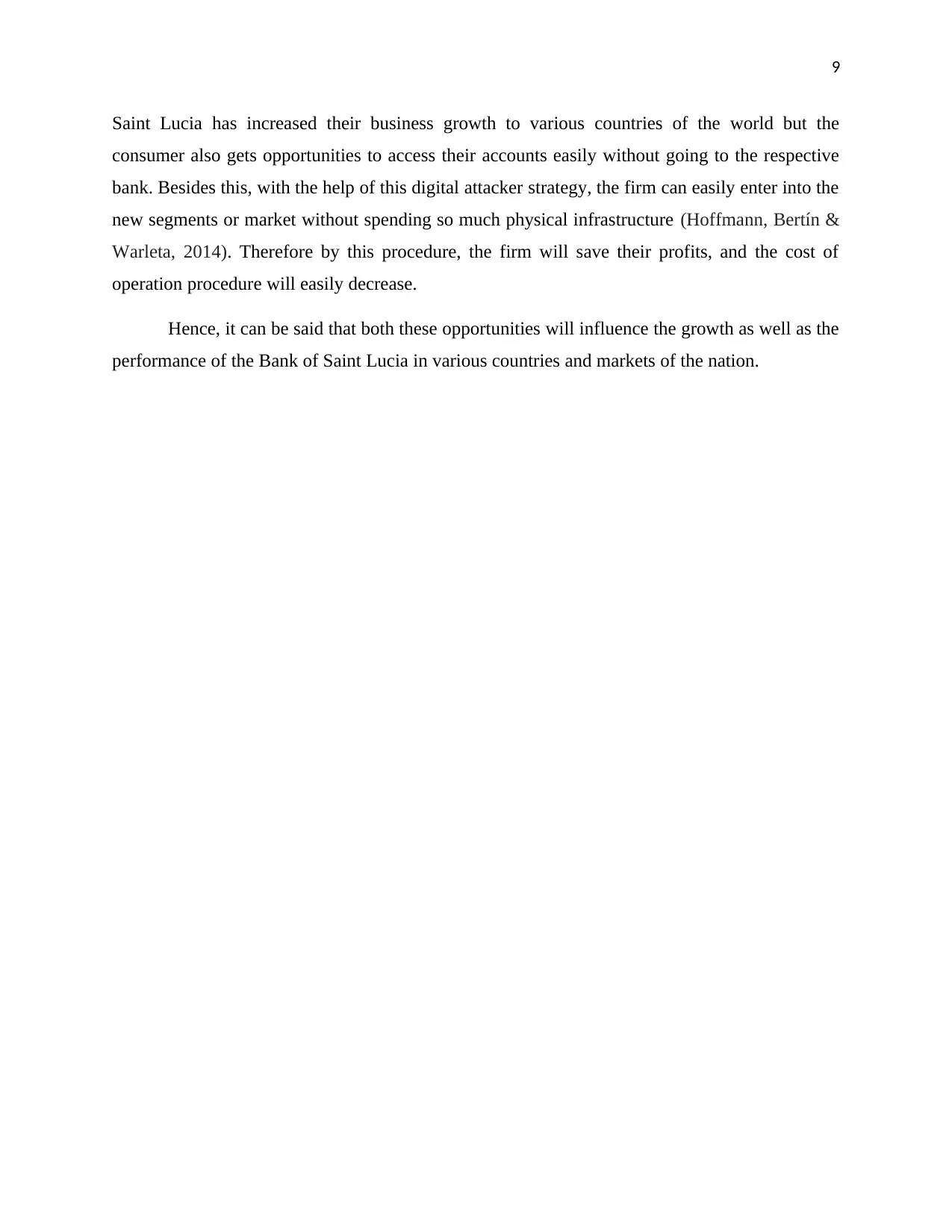
9
Saint Lucia has increased their business growth to various countries of the world but the
consumer also gets opportunities to access their accounts easily without going to the respective
bank. Besides this, with the help of this digital attacker strategy, the firm can easily enter into the
new segments or market without spending so much physical infrastructure (Hoffmann, Bertín &
Warleta, 2014). Therefore by this procedure, the firm will save their profits, and the cost of
operation procedure will easily decrease.
Hence, it can be said that both these opportunities will influence the growth as well as the
performance of the Bank of Saint Lucia in various countries and markets of the nation.
Saint Lucia has increased their business growth to various countries of the world but the
consumer also gets opportunities to access their accounts easily without going to the respective
bank. Besides this, with the help of this digital attacker strategy, the firm can easily enter into the
new segments or market without spending so much physical infrastructure (Hoffmann, Bertín &
Warleta, 2014). Therefore by this procedure, the firm will save their profits, and the cost of
operation procedure will easily decrease.
Hence, it can be said that both these opportunities will influence the growth as well as the
performance of the Bank of Saint Lucia in various countries and markets of the nation.
Secure Best Marks with AI Grader
Need help grading? Try our AI Grader for instant feedback on your assignments.
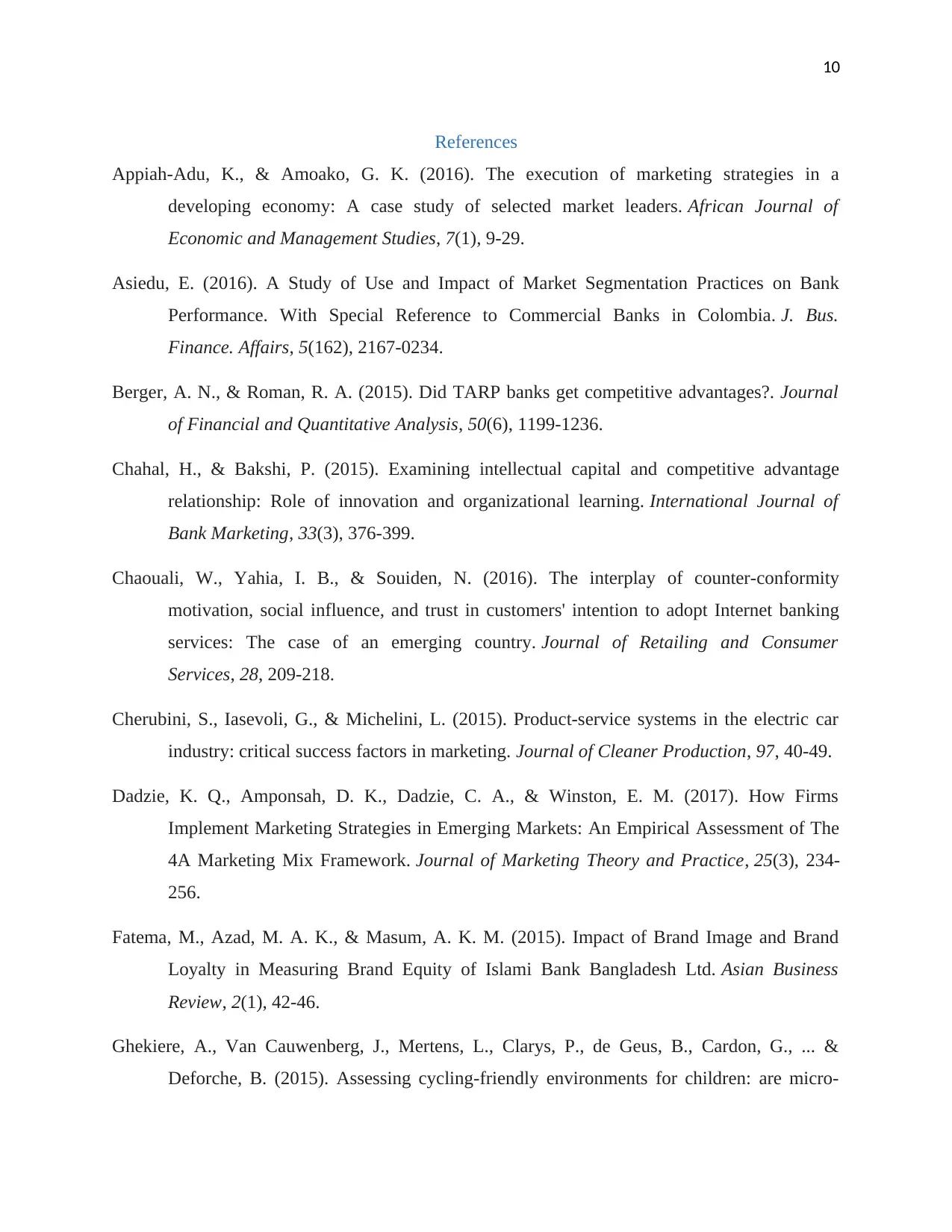
10
References
Appiah-Adu, K., & Amoako, G. K. (2016). The execution of marketing strategies in a
developing economy: A case study of selected market leaders. African Journal of
Economic and Management Studies, 7(1), 9-29.
Asiedu, E. (2016). A Study of Use and Impact of Market Segmentation Practices on Bank
Performance. With Special Reference to Commercial Banks in Colombia. J. Bus.
Finance. Affairs, 5(162), 2167-0234.
Berger, A. N., & Roman, R. A. (2015). Did TARP banks get competitive advantages?. Journal
of Financial and Quantitative Analysis, 50(6), 1199-1236.
Chahal, H., & Bakshi, P. (2015). Examining intellectual capital and competitive advantage
relationship: Role of innovation and organizational learning. International Journal of
Bank Marketing, 33(3), 376-399.
Chaouali, W., Yahia, I. B., & Souiden, N. (2016). The interplay of counter-conformity
motivation, social influence, and trust in customers' intention to adopt Internet banking
services: The case of an emerging country. Journal of Retailing and Consumer
Services, 28, 209-218.
Cherubini, S., Iasevoli, G., & Michelini, L. (2015). Product-service systems in the electric car
industry: critical success factors in marketing. Journal of Cleaner Production, 97, 40-49.
Dadzie, K. Q., Amponsah, D. K., Dadzie, C. A., & Winston, E. M. (2017). How Firms
Implement Marketing Strategies in Emerging Markets: An Empirical Assessment of The
4A Marketing Mix Framework. Journal of Marketing Theory and Practice, 25(3), 234-
256.
Fatema, M., Azad, M. A. K., & Masum, A. K. M. (2015). Impact of Brand Image and Brand
Loyalty in Measuring Brand Equity of Islami Bank Bangladesh Ltd. Asian Business
Review, 2(1), 42-46.
Ghekiere, A., Van Cauwenberg, J., Mertens, L., Clarys, P., de Geus, B., Cardon, G., ... &
Deforche, B. (2015). Assessing cycling-friendly environments for children: are micro-
References
Appiah-Adu, K., & Amoako, G. K. (2016). The execution of marketing strategies in a
developing economy: A case study of selected market leaders. African Journal of
Economic and Management Studies, 7(1), 9-29.
Asiedu, E. (2016). A Study of Use and Impact of Market Segmentation Practices on Bank
Performance. With Special Reference to Commercial Banks in Colombia. J. Bus.
Finance. Affairs, 5(162), 2167-0234.
Berger, A. N., & Roman, R. A. (2015). Did TARP banks get competitive advantages?. Journal
of Financial and Quantitative Analysis, 50(6), 1199-1236.
Chahal, H., & Bakshi, P. (2015). Examining intellectual capital and competitive advantage
relationship: Role of innovation and organizational learning. International Journal of
Bank Marketing, 33(3), 376-399.
Chaouali, W., Yahia, I. B., & Souiden, N. (2016). The interplay of counter-conformity
motivation, social influence, and trust in customers' intention to adopt Internet banking
services: The case of an emerging country. Journal of Retailing and Consumer
Services, 28, 209-218.
Cherubini, S., Iasevoli, G., & Michelini, L. (2015). Product-service systems in the electric car
industry: critical success factors in marketing. Journal of Cleaner Production, 97, 40-49.
Dadzie, K. Q., Amponsah, D. K., Dadzie, C. A., & Winston, E. M. (2017). How Firms
Implement Marketing Strategies in Emerging Markets: An Empirical Assessment of The
4A Marketing Mix Framework. Journal of Marketing Theory and Practice, 25(3), 234-
256.
Fatema, M., Azad, M. A. K., & Masum, A. K. M. (2015). Impact of Brand Image and Brand
Loyalty in Measuring Brand Equity of Islami Bank Bangladesh Ltd. Asian Business
Review, 2(1), 42-46.
Ghekiere, A., Van Cauwenberg, J., Mertens, L., Clarys, P., de Geus, B., Cardon, G., ... &
Deforche, B. (2015). Assessing cycling-friendly environments for children: are micro-
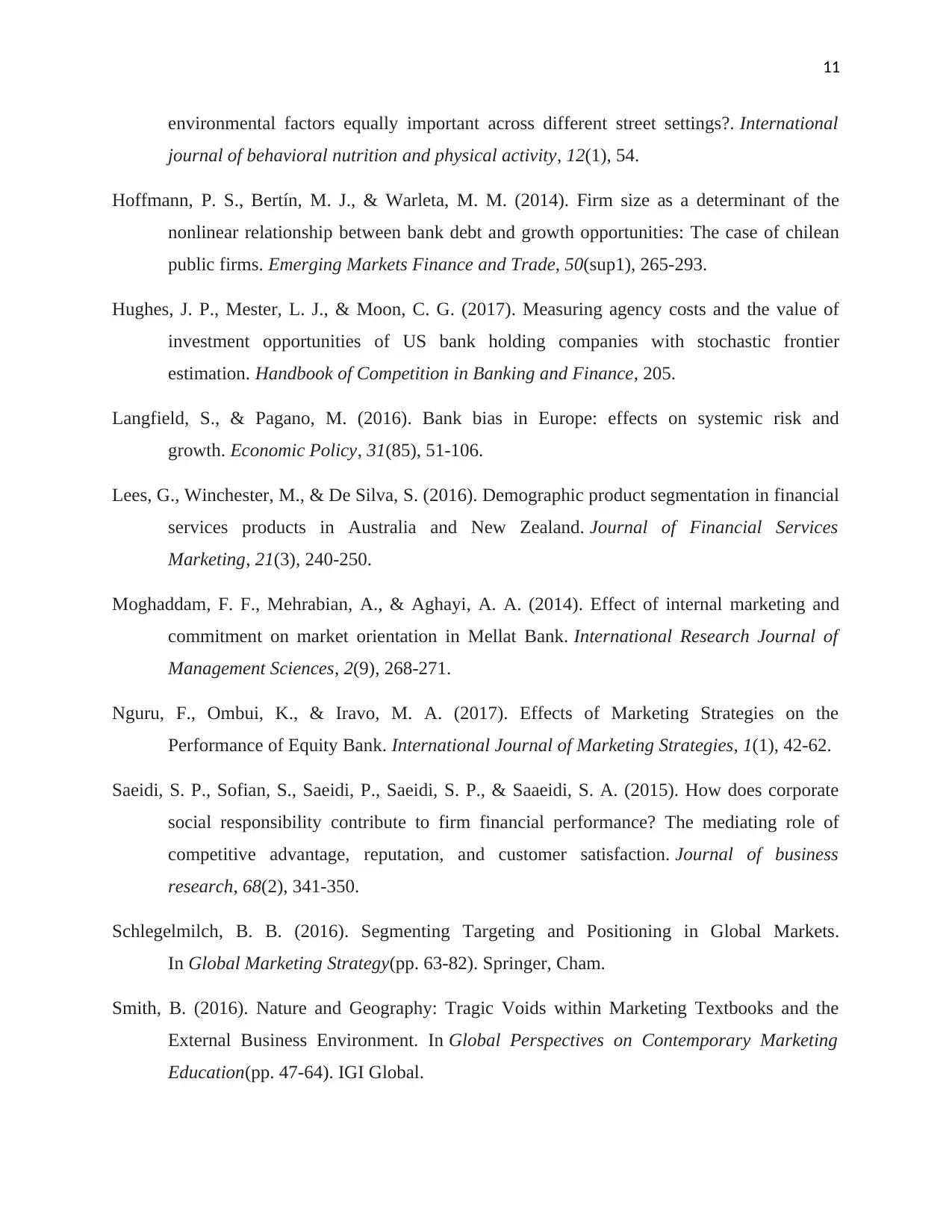
11
environmental factors equally important across different street settings?. International
journal of behavioral nutrition and physical activity, 12(1), 54.
Hoffmann, P. S., Bertín, M. J., & Warleta, M. M. (2014). Firm size as a determinant of the
nonlinear relationship between bank debt and growth opportunities: The case of chilean
public firms. Emerging Markets Finance and Trade, 50(sup1), 265-293.
Hughes, J. P., Mester, L. J., & Moon, C. G. (2017). Measuring agency costs and the value of
investment opportunities of US bank holding companies with stochastic frontier
estimation. Handbook of Competition in Banking and Finance, 205.
Langfield, S., & Pagano, M. (2016). Bank bias in Europe: effects on systemic risk and
growth. Economic Policy, 31(85), 51-106.
Lees, G., Winchester, M., & De Silva, S. (2016). Demographic product segmentation in financial
services products in Australia and New Zealand. Journal of Financial Services
Marketing, 21(3), 240-250.
Moghaddam, F. F., Mehrabian, A., & Aghayi, A. A. (2014). Effect of internal marketing and
commitment on market orientation in Mellat Bank. International Research Journal of
Management Sciences, 2(9), 268-271.
Nguru, F., Ombui, K., & Iravo, M. A. (2017). Effects of Marketing Strategies on the
Performance of Equity Bank. International Journal of Marketing Strategies, 1(1), 42-62.
Saeidi, S. P., Sofian, S., Saeidi, P., Saeidi, S. P., & Saaeidi, S. A. (2015). How does corporate
social responsibility contribute to firm financial performance? The mediating role of
competitive advantage, reputation, and customer satisfaction. Journal of business
research, 68(2), 341-350.
Schlegelmilch, B. B. (2016). Segmenting Targeting and Positioning in Global Markets.
In Global Marketing Strategy(pp. 63-82). Springer, Cham.
Smith, B. (2016). Nature and Geography: Tragic Voids within Marketing Textbooks and the
External Business Environment. In Global Perspectives on Contemporary Marketing
Education(pp. 47-64). IGI Global.
environmental factors equally important across different street settings?. International
journal of behavioral nutrition and physical activity, 12(1), 54.
Hoffmann, P. S., Bertín, M. J., & Warleta, M. M. (2014). Firm size as a determinant of the
nonlinear relationship between bank debt and growth opportunities: The case of chilean
public firms. Emerging Markets Finance and Trade, 50(sup1), 265-293.
Hughes, J. P., Mester, L. J., & Moon, C. G. (2017). Measuring agency costs and the value of
investment opportunities of US bank holding companies with stochastic frontier
estimation. Handbook of Competition in Banking and Finance, 205.
Langfield, S., & Pagano, M. (2016). Bank bias in Europe: effects on systemic risk and
growth. Economic Policy, 31(85), 51-106.
Lees, G., Winchester, M., & De Silva, S. (2016). Demographic product segmentation in financial
services products in Australia and New Zealand. Journal of Financial Services
Marketing, 21(3), 240-250.
Moghaddam, F. F., Mehrabian, A., & Aghayi, A. A. (2014). Effect of internal marketing and
commitment on market orientation in Mellat Bank. International Research Journal of
Management Sciences, 2(9), 268-271.
Nguru, F., Ombui, K., & Iravo, M. A. (2017). Effects of Marketing Strategies on the
Performance of Equity Bank. International Journal of Marketing Strategies, 1(1), 42-62.
Saeidi, S. P., Sofian, S., Saeidi, P., Saeidi, S. P., & Saaeidi, S. A. (2015). How does corporate
social responsibility contribute to firm financial performance? The mediating role of
competitive advantage, reputation, and customer satisfaction. Journal of business
research, 68(2), 341-350.
Schlegelmilch, B. B. (2016). Segmenting Targeting and Positioning in Global Markets.
In Global Marketing Strategy(pp. 63-82). Springer, Cham.
Smith, B. (2016). Nature and Geography: Tragic Voids within Marketing Textbooks and the
External Business Environment. In Global Perspectives on Contemporary Marketing
Education(pp. 47-64). IGI Global.
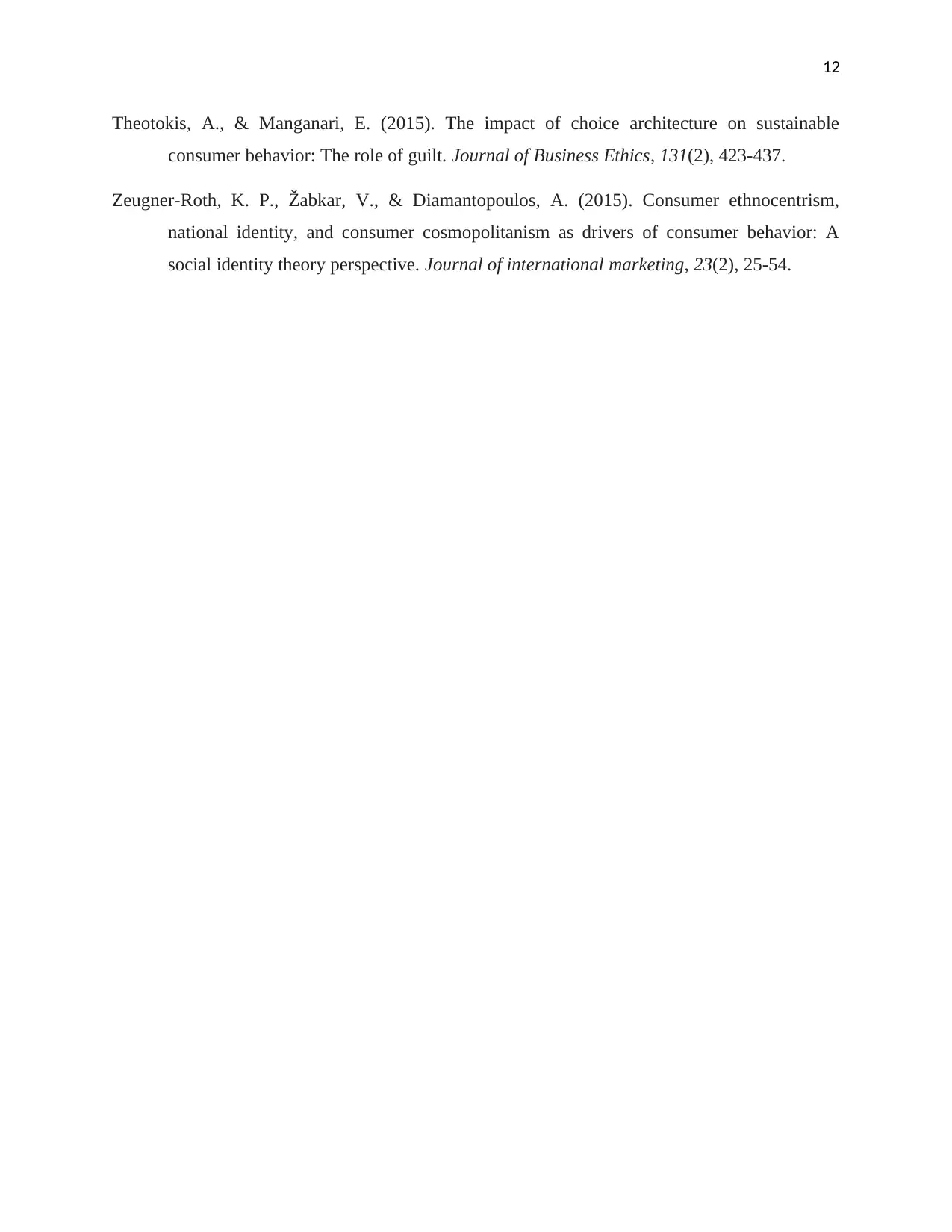
12
Theotokis, A., & Manganari, E. (2015). The impact of choice architecture on sustainable
consumer behavior: The role of guilt. Journal of Business Ethics, 131(2), 423-437.
Zeugner-Roth, K. P., Žabkar, V., & Diamantopoulos, A. (2015). Consumer ethnocentrism,
national identity, and consumer cosmopolitanism as drivers of consumer behavior: A
social identity theory perspective. Journal of international marketing, 23(2), 25-54.
Theotokis, A., & Manganari, E. (2015). The impact of choice architecture on sustainable
consumer behavior: The role of guilt. Journal of Business Ethics, 131(2), 423-437.
Zeugner-Roth, K. P., Žabkar, V., & Diamantopoulos, A. (2015). Consumer ethnocentrism,
national identity, and consumer cosmopolitanism as drivers of consumer behavior: A
social identity theory perspective. Journal of international marketing, 23(2), 25-54.
1 out of 13
Related Documents
Your All-in-One AI-Powered Toolkit for Academic Success.
+13062052269
info@desklib.com
Available 24*7 on WhatsApp / Email
![[object Object]](/_next/static/media/star-bottom.7253800d.svg)
Unlock your academic potential
© 2024 | Zucol Services PVT LTD | All rights reserved.





